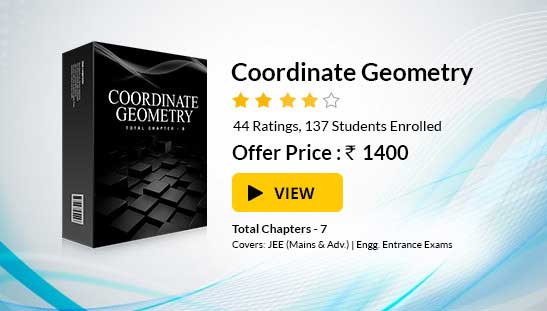Conjugate Hyperbola
What do you mean by a Conjugate Hyperbola?
 The hyperbola whose transverse and conjugate axes respectively are the conjugate and transverse axes of a given hyperbola is called the conjugate hyperbola of the given hyperbola. The asymptotes of these two hyperbolas are also the same.
The hyperbola whose transverse and conjugate axes respectively are the conjugate and transverse axes of a given hyperbola is called the conjugate hyperbola of the given hyperbola. The asymptotes of these two hyperbolas are also the same.
The conjugate hyperbola of the hyperbola x2/a2 – y2/b2 = 1 is x2/a2 – y2/b2 = -1.

Its transverse and conjugate axes are along y and x axes respectively.
Some key Points
-
Any point on the conjugate hyperbola is of the form (a tanθ, b secθ)
-
The equation of the conjugate hyperbola to xy = c2 is xy = –c2.
-
The equation of the hyperbola and asymptotes differ by the same constant by which the equations of the asymptotes and the conjugate hyperbola differ.
-
Hyperbola + Conjugate hyperbola = 2 (Pair of Asymptotes).
-
The tangents drawn at the points, where a pair of conjugate diameters meets a hyperbola and its conjugates form a parallelogram, whose vertices lie on the asymptotes and whose area is constant.
-
If a pair of conjugate diameters of hyperbola meet the hyperbola and its conjugate in P, P’ and D, D’ respectively, then the asymptotes bisect PD and PD’.
-
If e1 and e2 are the eccentricities of the hyperbola and its conjugate then e1-2 + e2-2 = 1.
-
Two hyperbolas with the same eccentricity are said to be similar.
-
The focus of a hyperbola and its conjugate are concyclic and and form the vertices of a square.
We now compare the hyperbola and the conjugate hyperbola closely by looking at their various parameters:
|
|
Hyperbola |
Conjugate Hyperbola |
|
Standard Equation |
x2/a2 – y2/b2 = 1 |
-x2/a2 + y2/b2 = 1 |
|
Centre |
(0,0) |
(0, 0) |
|
Equation of Transverse axis |
y = 0 |
x= 0 |
|
Equation of Conjugate axis |
x = 0 |
y = 0 |
|
Length of Transverse axis |
2a |
2b |
|
Length of Conjugate axis |
2b |
2a |
|
Vertices |
(±a, 0) |
(0, ±b) |
|
Foci |
(±ae, 0) |
(0, ±be) |
|
Equation of directrix |
x = ±a/e |
y = ±b/e |
|
Eccentricity |
e = √(a2+b2)/a2 |
e = √(a2+b2)/b2 |
|
Parametric Coordinates |
(a sec θ, b tan θ) |
(a tan θ, b sec θ) |
|
Length of Latus Rectum |
2b2/a |
2a2/b |
|
Tangent at the vertices |
x = ±a |
y = ±b |
Let us now study some of the illustrations based on conjugate hyperbola and the conjugate axis of a hyperbola:
The eccentricity e1 of the given hyperbola is obtained from
b2 = a2(e12 – 1). …… (1)
The eccentricity e2 of the conjugate hyperbola is given by
a2 = b2(e22 – 1). …… (2)
Multiply (1) and (2), we get,
1 = (e12 – 1)(e22 – 1) ⇒ 0 = e12 e22 – e12 – e22
⇒ e1–2 + e2–2 = 1.
Illustration:
Find the centre, eccentricity, foci, directrix and the lengths of the transverse and conjugate axes of the hyperbola whose equation is (x-1)2 – 2(y-2)2 + 6 = 0.
Solution:
The equation of the hyperbola can be written as (x-1)2 – 2(y-2)2 + 6 = 0.
We can rewrite it as Y2/(√3)2 – X2/(√6)2 = 1, where Y = (y-2) and X = (x-1)
Hence, we have the centre as X = 0, Y = 0 so (x-1) = 0and (y-2) = 0.
This gives x = 1 and y = 2.
This also means that a = √3 and b = √6 and hence the transverse axis = 2√3 and conjugate axis = 2√6.
We know b2 = a2(e2-1)
This means 6 = 3(e2-1) and so e = √3.
Hence, the foci are (1, 5) and (1, -1).
Equation of directrix is Y = ±a/e
Hence, directrices = y-2 = ± √3/√3 = ±1.
Hence, y = 3 or y = 1
Related Resources
-
Click here to refer the most Useful Books of Mathematics.
-
For getting an idea of the type of questions asked, refer the previous year papers.
To read more, Buy study materials of Hyperbola comprising study notes, revision notes, video lectures, previous year solved questions etc. Also browse for more study materials on Mathematics here.